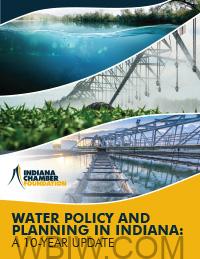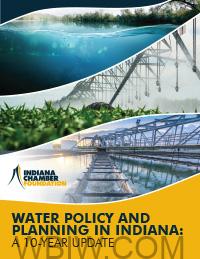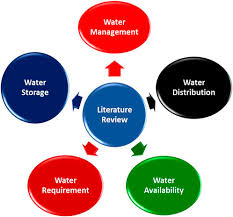
INDIANA — A decade ago, the Indiana Chamber of Commerce commissioned a study on the state’s water supply to provide an account of the vital resource for everyday life and economic development. Now, through the Indiana Chamber Foundation, the organization has released its follow-up research, “Water Policy and Planning: A 10-Year Update.”

This new report is intended to help set the stage for a state-wide integrated water management plan, a key infrastructure and energy priority in the Indiana Chamber’s Indiana Prosperity 2035 visioning plan.
Like the first effort, this study was prepared by INTERA Incorporated, which has a location in Bloomington.

“Today, we have more observations of water levels and more information about flows (than in 2014),” says Jack Wittman, project leader and vice president and principal water resource hydrologist for INTERA. “We have a framework for planning that we’ve simply never had before.”
That’s exactly what the Indiana Chamber sought to accomplish, remarks its president and CEO Vanessa Green Sinders.

“Water is such a critical resource for all Hoosiers and it’s imperative to assess current levels as well as help legislators and planners put Indiana in a strong position for the future. We’re grateful for the contributions of all involved in this important study, which we hope can help inform the next steps for local and state officials.”
The new report’s general findings reveal that water in the state is plentiful but not evenly distributed. Geographic distinctions abound. For instance, north of the Wabash River, every community, manufacturer, and irrigator reportedly has access to their groundwater or stream.

In central Indiana, however, water must be well-managed to meet demand as it contains diverse sources, including reservoirs, rivers, and well fields. In southern Indiana, “regional water systems have long been the foundation of growth and economic development,” according to the report, relying since the 1960s on sources that include Patoka Lake, Monroe Lake, and Brookville Reservoir.
One finding is that while total withdrawals for industrial use are declining overall, capacity may be added regionally as opportunities open for new development.
The study authors assert that new facilities need access to adequate cooling and process water and guidance for planning new wastewater returns to avoid conflict. In previous decades, industrial water use steadily declined, and the use of surface water correspondingly dropped.
The summary continues: “New developments could reverse this trend, so the state needs to consider these plans carefully as the availability within any basin is determined. Where local supplies cannot satisfy the demand for process water, proposals for inter-basin transfers need to be developed with some basic guidance and direction from the state.”
The report also reports that groundwater withdrawal has increased more rapidly than surface water diversions since the 2014 study. The state’s aquifers are becoming increasingly important as a means of satisfying seasonal demands while controlling treatment and conveyance costs.
Overall, Indiana has enough water for existing proposals and demand, thus putting the state in a much stronger position than its arid western counterparts. Yet the focus turns toward the future.
“What we have to do is think about how future demand might be distributed and how that looks, whether it’s a matter of organic growth from cities or whether we’re actually building mega-developments in particular areas,” Wittman offers. “In either case, we have to understand what the effects of high demand for water might be in different basins.”
The next phase of work will involve using the water study findings to craft meaningful legislation and processes. State and federal action will undoubtedly be key, but governments closer to the sources should also play a role.
“Local governments need to be more involved in the process,” Wittman suggests. “There are experiences that counties have now with being more directly involved in the question of water. That needs to be brought to the table and considered.”
Other recommendations include further emphasis on planning; continued coordination by the Indiana Finance Authority; sustainable funding; establishing criteria for setting environmental flows and a framework for data monitoring; developing guidance for regional plans; and cultivating a living state water plan (to build on regional plans).
For the Indiana Chamber, the study release is phase one. “Between now and the start of the legislative session, our organization will be meeting with key lawmakers to share the research and work collaboratively to help shape policy in 2025,” notes Sinders. “We also will be reaching out to local chambers and government officials across the state to highlight these findings and talk about what this means in their communities and how we can partner on enhanced resource planning.”
The research project also included consultations with the Indiana Chamber Water Resources Advisory Committee, which consists of representatives from water utilities, drinking water professional organizations, consultants, relevant state agencies, agriculture, aggregate operations, and environmentalists.
The water study’s investors are ACEC Indiana, AES Indiana, Aqua Indiana, Citizens Energy Group, Ginovus, Indiana American Water, Indiana Farm Bureau, Indiana Mineral Aggregates, Indiana Pork Producers, Indiana Section, American Water Works Association, Indiana Soybean Alliance/Indiana Corn Marketing Council, M.E. Simpson Company, Inc., National Association of Water Companies, Indiana Chapter, and The Nature Conservancy.
View the complete Indiana Chamber Foundation study at www.indianachamber.com/water.



